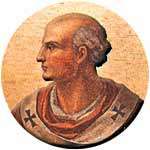Pope Sylvester III
| Pope Sylvester III | |
|---|---|
 | |
| Papacy began | 20 January 1045 |
| Papacy ended | 10 March 1045 |
| Predecessor | Benedict IX |
| Successor | Benedict IX |
| Personal details | |
| Birth name | Giovanni dei Crescenzi – Ottaviani |
| Born |
c. 1000 Rome, Papal States, Holy Roman Empire |
| Died |
1063 (aged 63) Sabina, Papal States, Holy Roman Empire |
| Other popes named Sylvester | |
Pope Sylvester III or Silvester III (1000 – October 1063), born Giovanni dei Crescenzi–Ottaviani in Rome, was Pope from 20 January to March 1045.
Background
Upon the death of Pope John XIX in October 1032, the papal throne became the subject of dispute between rival factions of nobles. Theophylactus, a youth of about twenty, was the son of Alberic III, Count of Tusculum was supported by the nobles of Tusculum. Giovanni de' Crescenzi–Ottaviani was supported by the Crescenzi family. Alberic secured the election of his son through bribery. The nephew and namesake of Pope Benedict VIII, he took the name Benedict IX. The young man was not only unqualified, but led a reportedly dissolute life, and factional strife continued. A revolt in Rome led to Benedict IX being driven from the city in 1044.[1]
Papacy
Giovanni de' Crescenzi (John), bishop of Sabina, was elected after fierce and protracted infighting. He took the name Sylvester III in January 1045. Benedict IX issued an excommunication of the new Pope[2] and in March returned to Rome and expelled Sylvester,[3] who himself returned to Sabina to again take up his office of bishop in that diocese.[4]
Nearly two years later (in December 1046), the Council of Sutri deprived him of his bishopric and priesthood and ordered him sent to a monastery.[5] This sentence was obviously suspended because he continued to function and was recognized as Bishop of Sabina until at least 1062.[6] A successor bishop to the see of Sabina is recorded for October 1063, indicating that John must have died prior to that date.[6]
Though some consider him to have been an antipope, Sylvester III continues to be listed as an official Pope (1045) in Vatican lists. A similar situation applies to Pope Gregory VI (1045–1046). His pontifical name was used again by Antipope Theodoric because, at that time, he was not considered a legitimate pontiff.
See also
- Crescentii, powerful Roman clan
Notes
- ↑ Lynch, Joseph H. and Adamo, Phillip C., The Medieval Church, Routledge, 2014, p. 156, ISBN 9781317563334
- ↑ Richard P. McBrien, Lives of the Popes, (HarperCollins, 2000), 172.
- ↑ Megan McLaughlin, Sex, Gender, and Episcopal Authority in an Age of Reform, 1000–1122, (Cambridge University Press, 2010), 63.
- ↑ John-Peter Pham, Heirs of the Fisherman : Behind the Scenes of Papal Death and Succession, (Oxford University Press, 2004), 57.
- ↑ F. Donald Logan, A History of the Church in the Middle Ages, 2nd edition, (Routledge, 2013), 96.
- 1 2 J.N.D. Kelly, A Dictionary of Popes, (Oxford University Press, 2010), 144.
References
- J.N.D. Kelly, A Dictionary of Popes, Oxford University Press, 2010.
- F. Donald Logan, A History of the Church in the Middle Ages, 2nd edition, Routledge, 2013.
- Richard P. McBrien, Lives of the Popes, HarperCollins, 2000.
- Megan McLaughlin, Sex, Gender, and Episcopal Authority in an Age of Reform, 1000-1122, Cambridge University Press, 2010.
- John-Peter Pham, Heirs of the Fisherman : Behind the Scenes of Papal Death and Succession, Oxford University Press, 2004.
External links
- (in Italian) Crescenzi family
| Catholic Church titles | ||
|---|---|---|
| Preceded by Benedict IX |
Pope 1045 |
Succeeded by Benedict IX |

